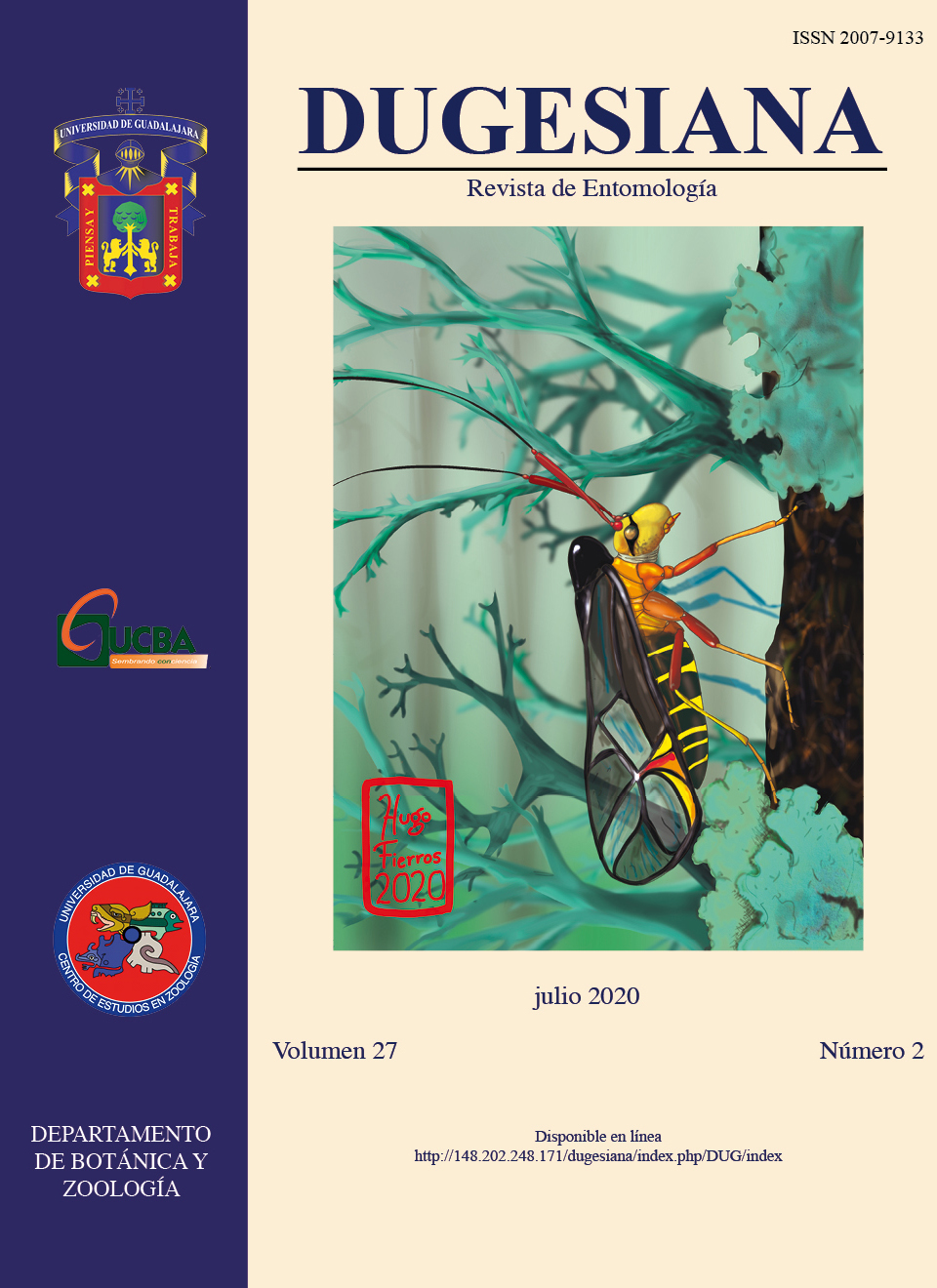Courtship and mating behavior in four Pachytroctid species (Psocodea: ‘Psocoptera’: Troctomorpha: Nanopsocetae: Pachytroctidae)
DOI:
https://doi.org/10.32870/dugesiana.v27i2.7104Keywords:
courtship, Pachytroctidae, mating behavior matingAbstract
Courtship and mating behavior were investigated in four species, representing three different genera, in the family Pachytroctidae. All exhibited a lengthy courtship in the male-above position followed by brief copulation in the female-above position with both facing in the same direction. This courtship behavior has not previously been observed in ‘Psocoptera’ and may be unique to Pachytroctidae. In three of the species in this study, the spermatophore remnant protruded from the tip of the male’s abdomen after copulation, and was immediately deposited on the surface of the experimental enclosure. Differences in courtship behavior of the two closely related and sympatric Tapinella species, described in this report, may represent reproductive isolating mechanisms. Under experimental conditions, we observed a male of each Tapinella species mount, court, and attempt to mate with a virgin female of the other species. In each case the female rejected the male and failed to mate. Implications relative to these behaviors are discussed. DOI links to videos are provided for easy access.References
Betz, B. W. 1983. The biology of Trichadenotecnum alexanderae Sommerman (Psocoptera: Psocidae) III Analysis of mating behavior. Psyche 90(1): 97-117.
Broadhead, E. 1961. The biology of Psoquilla marginepunctata (Hagen) (Corrodentia,Trogiidae). Transactions of the Society for British Entomology 14(10): 223-236.
Broadhead, E. 1952. A comparative study of the mating behavior of eight Liposcelis species. Transactions of the Ninth International Congress of Entomology 1: 381-383.
Duelli, P. and J. B. Johnson. 1981. Behavioral origin of tremulation, and possible stridulation, in green lacewings (Neuroptera: Chrysopidae). Psyche 88: 375-381.
Engelmann, F. 1970. The Physiology of Insect Reproduction, International Series of Monographs in Pure an Applied Biology, Vol. 44. Pergamon Press, Oxford, New York, Toronto, Sydney, Braunschweig.
Huber, B. A. 2010. Mating positions and the evolution of asymmetric insect genitalia. Genetica 138: 19-25.
Mann, T. 1984. Spermatophores, Zoophysiology, Vol. 15. Springer-Verlag, Berlin, Heidelberg, New York, Tokyo.
Mockford, E. L. 1993. North American Psocoptera, Flora & Fauna Handbook No. 10. Sandhill Crane Press, Inc. Gainesville, Florida.
Mockford, E. L. and J. J. Wynne. 2013. Genus Cyptophania Banks (Psocoptera: Lepidopsocidae): unique features, augmented description of the generotype, and descriptions of three new species. Zootaxa 3702(5): 437-449.
Mockford, E. L. and D. W. Young. 2019. Peritroctes bengalensis Thornton & Wong in Texas, first western hemisphere records and first description of the male, macropterous female, and egg (Psocodea: ‘Psocoptera’: Pachytroctidae). Entomological News 128(3): 233-242.
Sommerman, K. M. 1944. Bionomics of Amapsocus amabilis (Walsh) (Corrodentia: Psocidae). Annals Entomological Society of America 37: 359-364.
Sommerman, K. M. 1956. Two new species of Rhyopsocus (Psocoptera) from the U. S. A., with notes on the bionomics of one household species. Journal of the Washington Academy of Science. 46: 145-149.
Thornton, I. W. B. and S. K. Wong. 1966. Some Psocoptera from West Bengal, India. Transactions of the Royal Entomological Society of London 118(1): 1-21.
Wearing-Wilde, J. 1996. Mate choice and competition in the barklouse Lepinotus patruelis (Psocoptera: Trogiidae): The effect of diet quality and sex ratio. Journal of Insect Behavior 9(4): 599-612.
Additional Files
Published
Issue
Section
License
1. Proposed policy for open access journals
Those authors who have publications with this journal, accept the following terms:
- The authors will retain their copyright and will guarantee to the journal the right of first publication of their work, which will be simultaneously subject to the Creative Commons Recognition License, which allows third parties to share the work whenever their author is indicated and His first publication is this journal.
- Authors may adopt other non-exclusive license agreements to distribute the version of the published work (eg to be deposited in an institutional telematic file or published in a monographic volume) provided the initial publication is indicated in this journal .
Authors are encouraged and encouraged to disseminate their work through the Internet (eg in institutional telematic files or on their web page) before and during the sending process, which can produce interesting exchanges and increase appointments Of the published work. (See The effect of open access).
2. Proposed policy for journals that offer open deferred access
Those authors who have publications with this journal, accept the following terms:
- The authors will retain their copyrights and will guarantee to the journal the right of first publication of their work [SPECIFY PERIOD OF TIME], which will be simultaneously subject to the Creative Commons Recognition License that allows third parties to share the work always That its author and his first publication be indicated this journal.
- Authors may adopt other non-exclusive license agreements to distribute the version of the published work (eg to be deposited in an institutional telematic file or published in a monographic volume) provided the initial publication is indicated in this journal .
- Authors are encouraged and encouraged to disseminate their work through the Internet (eg in institutional telematic files or on their web page) before and during the sending process, which can produce interesting exchanges and increase appointments Of the published work. (See The effect of open access).




